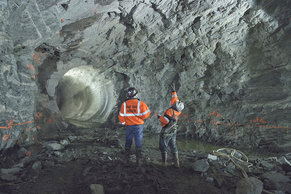 |
A-Z | Popular | Blog | Projects | Search » |
|
Project Management  Related Guides
Project Management
Key Concepts
Project Management
Project Metrics  Program Management Examples  |
17 Project Management Principles John Spacey, updated on
Project management principles are guidelines that an organization, program, project or professional adopts as a general approach to sponsoring, leading and managing projects. The following are illustrative examples.
Continuous ChangeChange is continuous. Project approaches that attempt to freeze change for long periods of time tend to fail. As such, it is often better to recognize that changes occur at any time.Empowered TeamsTeams have authority to get work done. Projects need motivated and committed leaders who have the authority and influence to clear issues.Face To FaceTeams frequently communicate verbally. It is best if a team can sit together.Fail WellFailure is quick, cheap and safe. Risks are identified and treated such that releases can only fail quickly, cheaply and safely.Iterative LifecycleProjects are a series of short iterations. Each iteration is a complete cycle from planning to deployment. The length of iterations is short with the largest of projects handled with iterations of weeks in duration.Knowledge CaptureKnowledge is captured. Documentation explains the reasons for decisions including alternatives that were considered. Knowledge capture is focused on analysis and insight.Learning From FailureFailure is openly managed. Setbacks can be expected of any ambitious initiative. As such, openly managing failure, learning from it and bouncing back without loss of motivation is a productive approach.Lightweight MethodologyProject management is a lightweight process. The startling complexity of managing large programs and projects with conventional waterfall methodologies tends fail in painful ways. Small scale iterative approaches allow project management processes to be lightweight and flexible.Motivated TeamsTeams are high performance. A skilled, motivated and energized team of ten people can outperform a mediocre and disengaged team of hundreds. As such, teams aren't treated as a commodity resource but are valued and carefully cultivated. Performance is rewarded and performance issues are managed without delay.Open InformationTeams are informed and openly share information. Fights the bizarre tendency for teams to hide information from each other and for management to hide information from their team.Project CultureTeams embrace a set of values, norms, habits and expected behaviors. Culture is both explicitly defined and developed to make it a group habit. Basic norms such as candor and treating each other with respect can bring large gains in efficiency and risk reduction.Project NarrativeA project has a compelling narrative. If something is worth doing it can be explained with an interesting narrative that instantly conveys its value.Project PrioritiesPriorities are ordered. Prioritization schemes based on rankings result in everything being ranked high priority. In order to keep iterations short, requirements need to be strictly ordered. In many cases, only a few requirements can be addressed per release. A backlog of requirements is maintained. It is acceptable for the backlog to grow very large. Priority ordering of a large backlog ensures that the highest priority items are always being implemented.Ship OftenFeatures are shipped often. Work is continuously integrated, tested and released. At the beginning of a project, the focus is getting something launched even if it has minimal value from the start. Features are then added regularly and value quickly scales up.Small Interdisciplinary TeamsProject teams are small and interdisciplinary. Teams are close-knit, dedicated units of no more than 16 members or so. They are designed to be complete with representatives from business, operations, architecture and technology. Each member both contributes work and potentially represents the interests of an organizational unit.Sustainable EffortWork is produced at a sustainable pace. Teams are valued as high performance units that have long term value that is not to be compromised by burning people out in a panic over short term goals.Working FeaturesProgress is measured in working features. Teams have leverage to organize their work in any way they see fit. Progress is measured in working features that are regularly released.Project ManagementThis is the complete list of articles we have written about project management.If you enjoyed this page, please consider bookmarking Simplicable.
Continuous ChangeThe definition of continuous change with examples.Project RiskA list of common project risks.Project Management BasicsA list of basic project management techniques.Workaround
A definition of workaround with examples.
Project Branding
A list of project branding techniques.
Stakeholder ManagementAn overview of project stakeholder management with examples.Action PlanA definition of action plan with examples.Cost Overrun
The primary types of cost overrun.
Document ControlThe definition of document control with examples.Project Oversight
A guide to project oversight.
Design-Driven Development
A definition of design driven development with examples.
Project RiskA list of common project risks.Project StakeholderA list of common project stakeholders.Business RisksA list of common business risks.Risk vs Issue
The difference between a risk and an issue.
Risk TreatmentThe five things that can be done about risk.Secondary Risk
The definition of secondary risk with examples.
Risk Register
A guide to creating a risk register with an example.
Risk Perception
A definition of risk perception with examples.
ImplementationThe common types of implementation.Project Risk Management
A reasonably complete guide to project risk management.
TrendingThe most popular articles on Simplicable in the past day.New ArticlesRecent posts or updates on Simplicable.
© 2010-2023 Simplicable. All Rights Reserved. Reproduction of materials found on this site, in any form, without explicit permission is prohibited. View credits & copyrights or citation information for this page. |